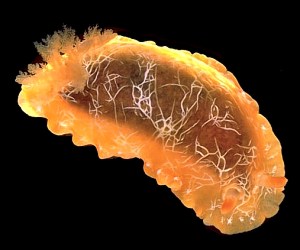
Doriopsilla miniata
(Alder & Hancock, 1864)
Order: NUDIBRANCHIA
Suborder: DORIDINA
Superfamily: EUDORIDOIDEA
Family: Dendrodorididae
DISTRIBUTION
Tropical and subtropical Indo-West Pacific.
PHOTO
UPPER RIGHT: North Coast New South Wales, November 1987, 21mm long.
LOWER LEFT: Woolgoolga area, Northern NSW, November 1982 (AMC136137)
LOWER RIGHT: Coffs Harbour region, New South Wales, December 1990, 27mm long.
PHOTOS: Bill Rudman.
Ranges in colour from translucent white to deep orange. Usually has a distinctive reticulate pattern of white lines but sometimes only traces of this pattern are present, and in rare cases no white is present.
Compare with Dendrodoris citrina, Doriopsilla carneola and Doriopsilla aurea. See discussion below discussing differences in egg morphology between D. miniata and the very similar Atlantic species, Doriopsilla areolata.
Reference:
• Alder, J. & Hancock, A. (1864) Notice of a collection of Nudibranchiate Mollusca made in India by Walter Elliot, Esq., with descriptions of several new genera and species. Transactions of the Zoological Society of London 5: 113-147.
• Rose, R. A. (1985} The spawn and development of twenty-nine New South Wales opisthobranchs (Mollusca: Gastropoda). Proceedings of the Linnean Society of New South Wales, 108(1): 23-36.
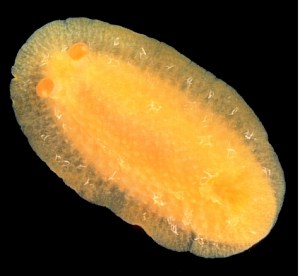
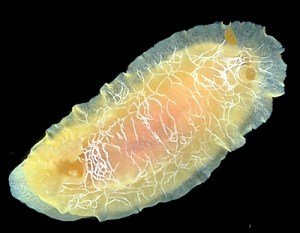
Rudman, W.B., 2000 (March 14) Doriopsilla miniata (Alder & Hancock, 1864). [In] Sea Slug Forum. Australian Museum, Sydney. Available from http://www.seaslugforum.net/find/dorimini
Related messages
Re: Doriopsilla miniata from the Gulf of Kutch, India
May 29, 2009
From: Apte Deepak
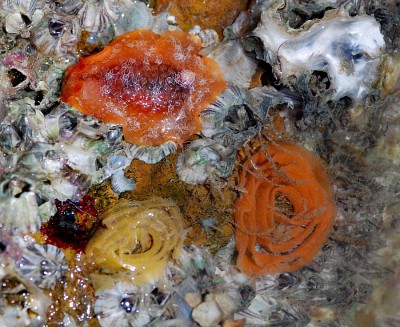
Concerning message #22375:
Dear Dr. Bill
Thank you for your confirmation on Doriopsilla miniata. Find attached two images. One with D. miniata with eggcase. The another egg case (yellow coloured) in the image is that of yellow coloured specimen of D. miniata. We get these two distinct colour forms, orange with orange coloured eggcase and yellow with yellow coloured eggcase.
Locality: Gulf of Kutch, exposed reef under rock, Gujarat, Arabean Sea. Length: 20 mm. Photographer: Deepak Apte and Vinod Gajjar.
The image send earlier (which is put up on forum) was actually the eggcase of the animal illustrated which I thought of D. peculiaris.
Both yellow and orange forms of D. miniata are not very common (while the other yellow species - which laid the eggcase in the earlier message - is abundant and seen through the entire winter from October till April.
Deepak
spiderconch@gmail.com
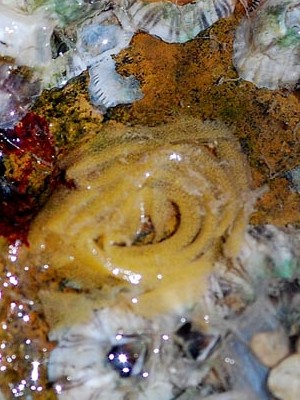
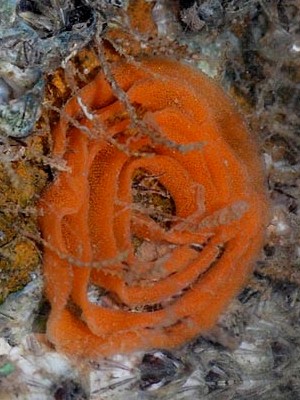
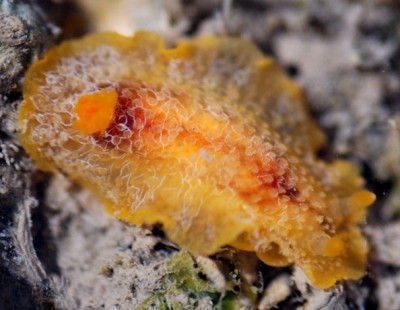
Dear Deepak,
Thanks for clarifying these species. The yellow egg-laying one in your earlier message certainly looks different, and when we compare its egg mass with the ones in today's message the egg size and number seems different also. I would consider the eggs in today's message to be smaller and more numerous. Which raises another question. They certainly look different to the eggs I referred to from Australia [message #10469]. This could mean Doriopsilla miniata has more than one development type or that there are a number of similar-looking cryptic species spread around the Indo-West Pacific - and Atlantic as well, if we include D. areolata.
Best wishes,
Bill Rudman
Doriopsilla miniata from the Gulf of Kutch, India
May 25, 2009
From: Apte Deepak
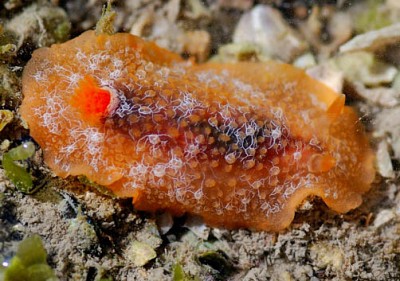
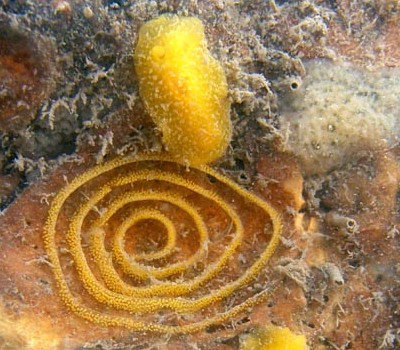
Dear Dr. Bill
We had great expedition to the Gulf of Kutch, Gujarat, India. We got about 20 species in three days. Are these Doriopsilla peculiaris ?
Locality: Gulf of Kutch, Exposed reef, Gujarat, India, Arabian Sea, 27 March 2009, Muddy reef. Length: 10 mm. Photographer: Deepak Apte.
Deepak Apte
spiderconch@gmail.com
Apte D.A., 2009 (May 25) Doriopsilla miniata from the Gulf of Kutch, India. [Message in] Sea Slug Forum. Australian Museum, Sydney. Available from http://www.seaslugforum.net/find/22375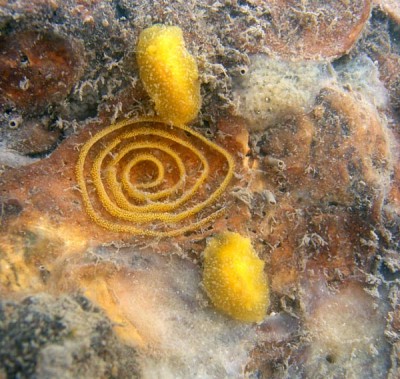
Dear Deepak,
The animal in your upper photo is definitely Doriopsilla miniata, which was described from the east coast of India about 150 years ago. I am not so sure about the yellow animals in your second photo. Did you see one of them laying the egg ribbon? The eggs in it look relatively large, suggesting the larvae will be direct developers without a free-living larval stage. However unless we know for certain that the egg ribbon belongs to one of them we can't say whether this is relevant or not. Why I mention it is that D. miniatahas direct developing eggs [see message #10469]. However that species usually has some indication of the white lines on the mantle so it may be a different species.
It is unlikely to be Doriopsilla peculiaris, because that species is considered to be a southern Australian species.
Best wishes,
Bill Rudman
Re: Doriopsilla miniata and its egg-ribbons
July 18, 2003
From: Kirsten Benkendorff
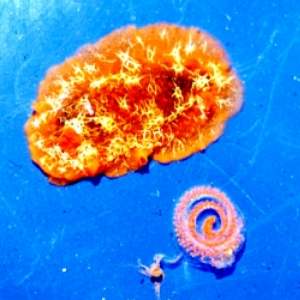
Hi Bill and Marina,
I was interested to see your Marina's pictures of Doriopsilla areolata and its egg-ribbons. I agree with Bill that the adults look very similar to Doriopsilla miniata but the egg masses are quite different - see my picture of eggs deposited in the lab - same egg masses were observed with the adults in the field. The eggs are red not yellow, much larger and fewer in number!
Doriopsilla miniata collected from North Shellharbour, [near Wollongong, New South Wales, Australia] with egg ribbon deposited in aquaria, January, 1998
Cheers,
Kirsten
kirsten.benkendorff@flinders.edu.au
Thanks Kirsten,
Your photo and Marina's well illustrates the value of recording and identifying egg ribbons, feeding behaviour etc. Bob Rose (1985) reported that D. miniata had a form of direct development in which the embryo in the egg capsule, goes through a veliger stage but the veliger is not fully developed - they lack an operculum, the velum is much reduced etc - and then the larva metamorphoses into a small crawling slug before hatching. As we can see in Kirsten's photo, the eggs are much larger and fewer than in Marina's photos of the egg ribbons of D. areolata. I can find no information on the development type of the Atlantic D. areolata, but from the much smaller egg size I would suspect it is not a direct developer, and so despite their external similarity, these 2 species are clearly distinct.
• Rose, R. A. (1985} The spawn and development of twenty-nine New South Wales opisthobranchs (Mollusca: Gastropoda). Proceedings of the Linnean Society of New South Wales, 108(1): 23-36.
Best wishes,
Bill Rudman.
Doriopisilla miniata from South Africa
February 8, 2003
From: Rudolph van Jaarsveld
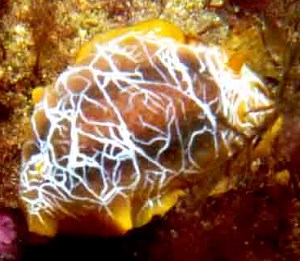
Dear Bill,
Attached please find more photos taken this year off Simon Town in False Bay, South Africa [January 2003].
Regards.
Rudolph van Jaarsveld
rudolph.vanjaarsveld@tcm.co.za
Van Jaarsveld, R., 2003 (Feb 8) Doriopisilla miniata from South Africa. [Message in] Sea Slug Forum. Australian Museum, Sydney. Available from http://www.seaslugforum.net/find/9167Dear Rudolph,
This is Doriopsilla miniata which is found throughout the tropical Indo-West Pacific region. Like species of the related genus Dendrodoris, species of Doriopsilla are suctorial feeders on sponges. They have lost the radular teeth, used by most dorids to scrape or bite off chunks of their food, and instead release digestive juices on to the sponge, near their mouth, and suck up the resulting 'sponge soup'.
Best wishes,
Bill Rudman
Doriopsilla miniata from Sth Africa
August 7, 2001
From: Valda Fraser
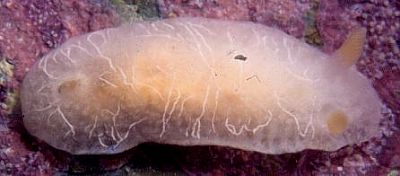
Dear Bill,
I saw quite a few of these small nudibranchs. They feel quite hard to the touch. I wonder what they are?
Locality: Brazenhead, Eastern Cape, SOUTH AFRICA, 25m
Date: July 2001
Size: 8mm
Thanks,
Valda Fraser
valdafraser@mweb.co.za
Fraser, V., 2001 (Aug 7) Doriopsilla miniata from Sth Africa. [Message in] Sea Slug Forum. Australian Museum, Sydney. Available from http://www.seaslugforum.net/find/4862Dear Valda,
They are Doriopsilla miniata. The white lines on the mantle and the relatively hard feel are pretty convincing characters
Best wishes,
Bill Rudman.
Dendrodoris miniata from Port Stephens, NSW
May 22, 2000
From: Ron Greer
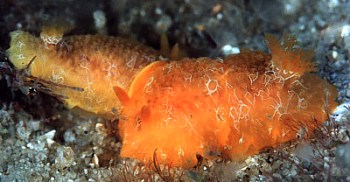
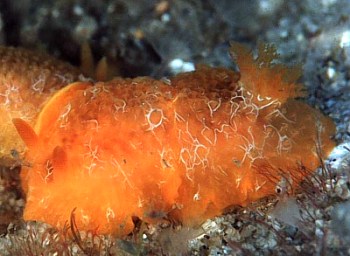
Dear Bill,
Late last year I sent you a couple of images for ID that you confirmed as Petalifera ramosa. That week of diving was the most prolific I had seen in 10 years at Fly Point [Port Stephens, New South Wales, Australia]. I used mainly slide film and have only recently had them scanned.
Of the 25+ species I saw there were 5 that I have been unable to ID. Attached is the first, which I am hoping you can ID.
Regards,
Ron.
diveimage@i-o.net.au
Greer, R., 2000 (May 22) Dendrodoris miniata from Port Stephens, NSW. [Message in] Sea Slug Forum. Australian Museum, Sydney. Available from http://www.seaslugforum.net/find/2428Dear Ron,
This is Dendrodoris miniata. A widepread species throughout the Indian Ocean and West Pacific, it ranges in colour from almost cream, through yellow to bright orange. The bright white reticulate pattern is usually present to some extent but in some case it can be entirely absent.
See the top of the page for a range of colour forms.
Best wishes,
Bill Rudman.
